Quiz Security and Integrity in MyCanvas Including Respondus LockDown Browser and Monitor
Digital Skills Services
Last Update 2 months ago
In your course assessments, how you design, deliver, and manage your questions and quizzes is a delicate balancing act between three broad and often opposing considerations- academic integrity, accessibility, and security measures.
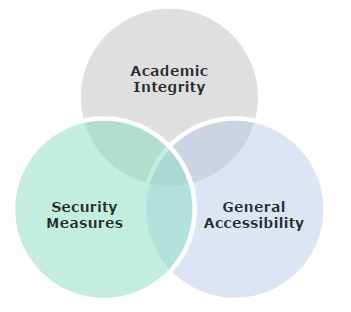
This is especially true in remote deliveries. A greater focus on one of these factors will tend to add complications to the others. As an example, increasing the accessibility of a quiz may make it easier for students to plagiarize or cheat, thereby affecting the academic integrity. In the same way, adding a technical security measure to the quizzing session, in an attempt to minimize plagiarism or cheating, may interfere with the accessibility of the quiz. You will need to find the balance of these considerations that best fits your students and your testing goals.
One method to try to assure the integrity of your quizzes, and of the quizzing sessions, is to add the security measure of one of two College-supported products- Respondus LockDown Browser, and Respondus Monitor. Using either of these tools presents another set of challenges, and should only be considered after ensuring that other measures have been taken.
Suggestions for Making Online Quizzes Secure
Before considering the use of one of the Respondus options, you should consider these methods that further reduce the risk of cheating. Each approach below provides another layer of security, and employing one or two of these items can often provide sufficient security for most assessments.
• Have a Policy: Include a statement in your course that cheating is not tolerated, how it will be managed, and be precise in what behaviours you consider to be disallowed.
• Communication: Be clear with students that you have access to quiz logs which provide insight into the students’ browsing behaviour while taking quizzes.
• Question Types: Consider replacing multiple choice and true/false question types with more challenging types, like Essay, Formula, Numerical Answer, or Fill in the Blank. There are many such types available in MyCanvas.
• Weighting: Make electronic quizzes a small proportion of the grade, and reduce the incentive to cheat by allocating a lesser weight.
• Digital Devices: Maintain a no-device policy during quizzes.
• Quiz Passwords (MyCanvas quiz setting): A quiz password prevents students from accessing the exam until a password has been supplied. Quiz passwords can be typed by the proctors themselves (for added security) or conveyed to the student at the start of the exam.
• Attempts Allowed (MyCanvas quiz setting): By only allowing one attempt for a quiz, students won’t be able to determine the questions in the quiz, look up the answers at a later time, and then retake the quiz.
• Randomize Options (MyCanvas quiz setting): Answer choices to multiple choice and multi-select questions can easily be randomized. This setting is selected at the time a quiz is created.
• Question Randomization (MyCanvas quiz setting): Question randomization ensures that the question order is different for each student. To create a randomized quiz, you need to build your questions in a Question (Classic Quizzes) or Item (New Quizzes) Bank first, then create a question group in your quiz, and draw the questions from the bank into the quiz.
• IP Restriction (MyCanvas quiz setting): If quizzes are being delivered from a central location, the IP address (or a partial address) for those computers can be specified, thus preventing access from other locations.
• Availability Dates and Times (MyCanvas quiz setting): This setting restricts the availability of the quiz to a specific date/time range. Carefully consider the time allowed to do a quiz, considering the complexity or difficulty of the questions.
• Proctors: Having students take an exam in a room being monitored by a proctor is a major deterrent to most forms of cheating. Alternatively, monitoring a remote class from within a MS Teams or Zoom session can also be effective.
Considerations When Choosing to Use Respondus
While the addition of a technological component like Respondus can make it more difficult for students to cheat and to share quiz questions, it also adds a significant layer of complexity to the quiz-taking experience:
• In a given quiz session, it is not unusual for some students to encounter technical problems, either initiating the session or during the session.
• Some students will choose not to take a quiz using Respondus LockDown Monitor. It is not unusual for some to refuse to install RLDB on their personal machines, or to take issue with the fact that Monitor video records them.
As an instructor, you need to accept that requiring the use of RLDB for a quiz will likely result in some students not taking the quiz, by choice or by circumstance. You will need to develop a policy that determines how you will treat these cases, and how you will accommodate them.
In the case of Respondus Monitor:
• The pre-quiz set-up procedures can be intimidating and stressful for some students, already apprehensive because of the quiz.
• Student may not have a webcam on their computer, disallowing them to take the quiz.
• Student may not have sufficient Internet bandwidth. They may pass the pre-quiz setup but the session recording fails when the connection becomes unstable.
• Student may be unwilling to allow a recording of their face, a requirement of using Monitor.
Also, it needs to be understood that Respondus LockDown Browser and/or Monitor is not a total solution to ensure academic integrity. For example:
• Students working from remote locations could use two computers at once (one for taking the exam under LockDown Browser, the other for accessing other applications).
• Students can use cameras and phones to capture and share screen content, send text messages, or refer to external resources.
• Respondus Monitor will not flag all suspect behaviours. To get a more complete accounting of the student’s behavior during the quiz, you may need to watch the student videos in their entirety.
What is Respondus LockDown Browser + Monitor?
Respondus LockDown Browser is a customized browser that increases the security of online quizzing in MyCanvas. When students use LockDown Browser to take a quiz, they are unable to print, copy, go to another URL, or access other applications until the quiz has been submitted. As an instructor, you can choose which of your MyCanvas quizzes will require students to use LockDown Browser.
Respondus Monitor adds an additional level of security to your quizzes by requiring that students also use a webcam to record themselves as they take quizzes. Each student’s quiz attempt is recorded, and the recordings are available to you shortly after the session. Monitor also provides a set of snapshot images of key moments during the session, and provides other indicators of the likeliness of cheating.
Functionality of LockDown Browser
The use of Respondus LockDown Browser effectively creates a secure testing environment for MyCanvas and includes a number of features, including:
• Assessments are displayed full-screen and cannot be minimized
• Browser menu and toolbar options are removed, except for Back, Forward, Refresh and Stop
• Prevents access to other applications including messaging, screen-sharing, virtual machines, and remote desktops
• Printing and screen capture functions are disabled
• Copying and pasting anything to or from an assessment is prevented
• Right-click menu options, function keys, keyboard shortcuts and task switching are disabled
• Can be configured such that students cannot exit until the the quiz is submitted for grading
• Assessments that are set up for use with LockDown Browser cannot be accessed with other browsers
LockDown Browser should only be used by students to take quizzes; it is not a replacement for a regular web browser.
Enabling LockDown Browser for a Quiz
To require students to use LockDown Browser for a MyCanvas quiz, you must enable LockDown Browser for the quiz.
1. Ensure that the LockDown Browser link is visible on the Course Navigation menu. If the link is not available:
• Visit Settings from the Course Navigation menu
• Choose the Navigation tab
• Drag the LockDown Browser item from the hidden section to the visible section. Note that even when enabled this way, the link will not be visible to students.
• Save your changes.
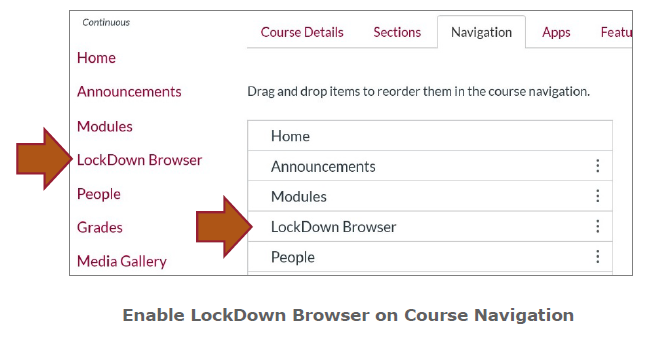
2. Visit the LockDown Browser link on the Course Navigation menu to view a list of all the quizzes in the course. Select the actions dropdown menu immediately to the left of the quiz name.
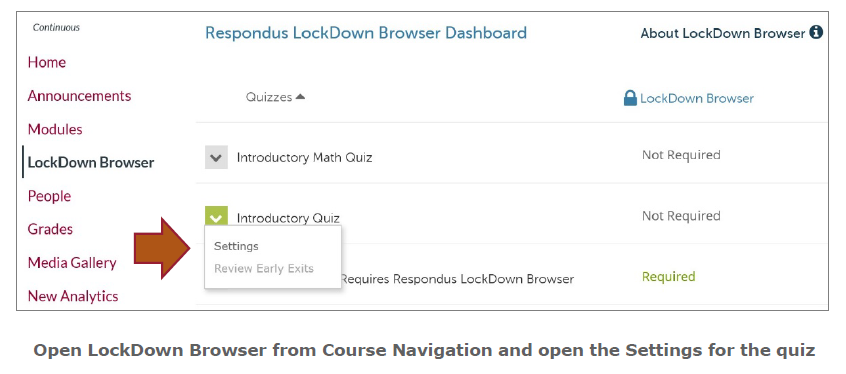
3. Click or press Settings, and select Require Respondus LockDown Browser for this exam. Open the Advanced Settings to open an additional set of options and select them as desired. To learn more about each option, click or press on the [explain] link beside the option.
4. Click or press Save + Close. You can confirm that LockDown Browser has been successfully applied when you see that the quiz name has updated, in the LockDown Browser listing and throughout MyCanvas, to include “Requires Respondus LockDown Browser”.
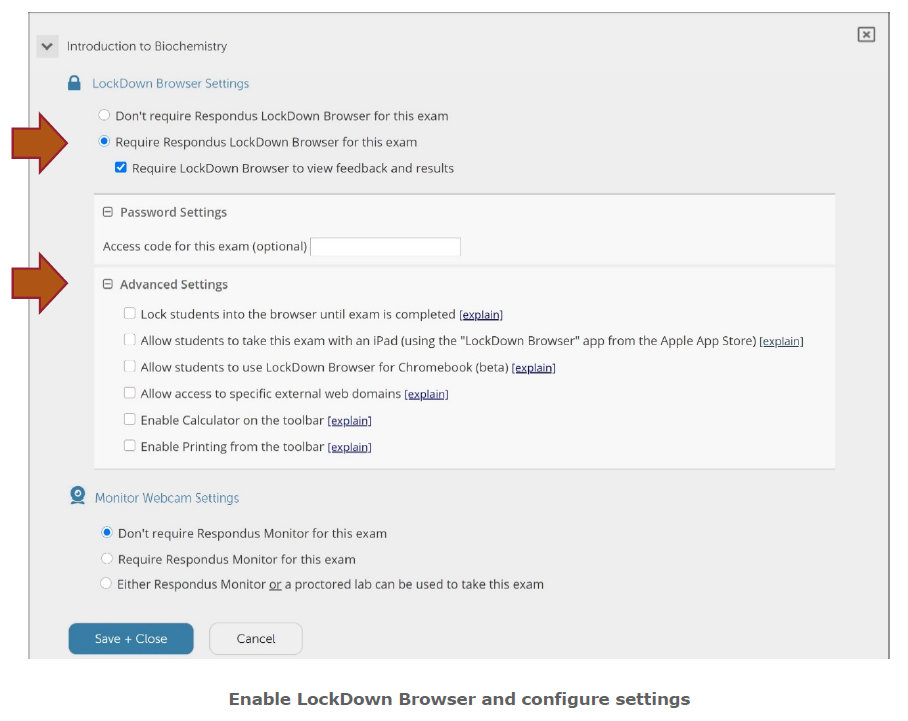
Enabling Respondus Monitor
Enabling Respondus Monitor requires that Respondus LockDown Browser is also enabled, and is configured in the same Settings.
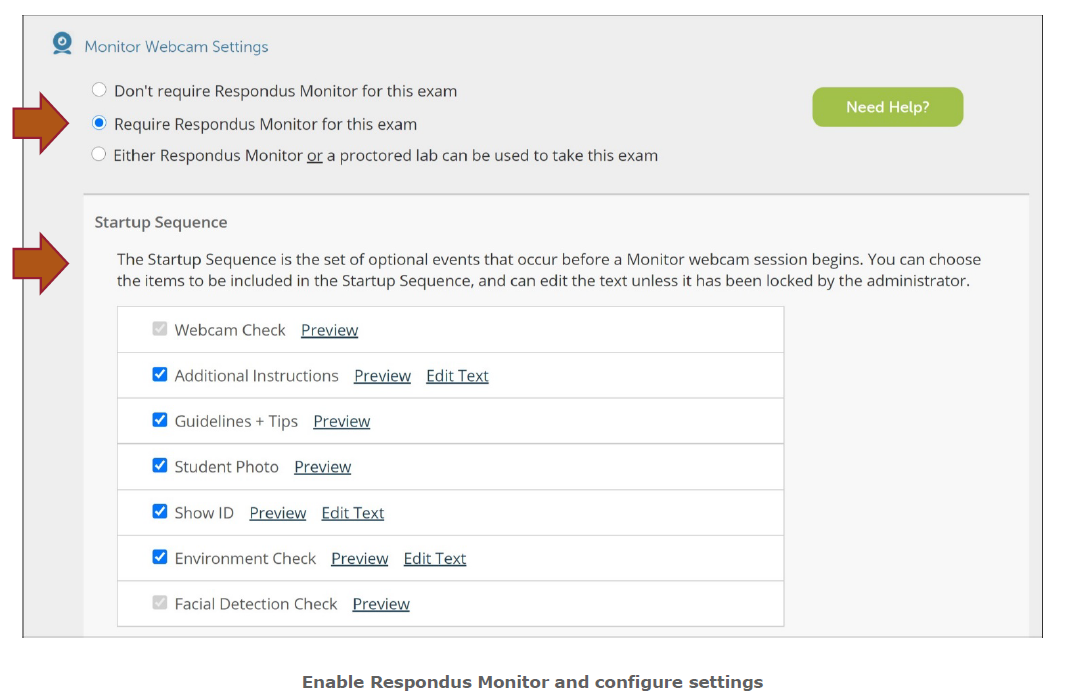
1. After enabling Require Respondus LockDown Browser for this exam, select Require Respondus Monitor for this exam under Monitor Webcam Settings.
2. Configure your settings for the Startup Sequence.
• Some settings, including the Webcam Check and Facial Recognition Check, are enabled by the College and cannot be disabled.
• For other settings, you can view and customize the prompts that the students see by clicking/pressing Edit Text.
3. Confirm the selections for Facial Detection Options and Advance Settings; in most cases the default settings are appropriate.
4. Click/press Save + Close. Any quizzes that require Respondus Monitor will now be renamed to include “Requires Respondus LockDown Browser + Webcam.”
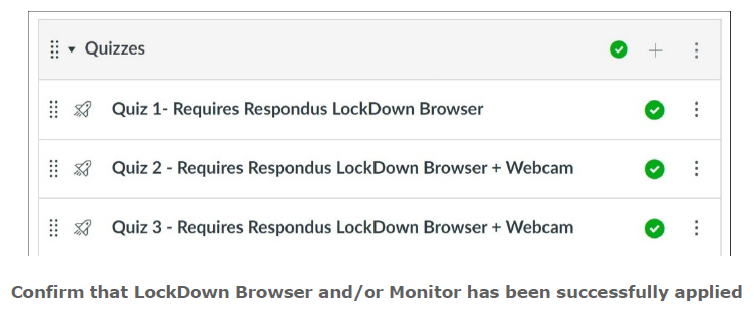
Testing the Configured Quiz
It is advisable to test the quiz with the MyCanvas student test account to confirm the correct configuration. If configured correctly, you should be unable to start the quiz with a standard web browser when you click or press Take This Quiz.
The Student Experience
Make sure students know, well in advance, if quizzes in your course will require Respondus LockDown Browser, especially if they will be taking the quiz(zes) on their personal computer, requiring that they install the LockDown Browser software. It is also good practice to create a short, non-graded demo quiz that requires the use of LockDown Browser, and allow students to test the browser before you require it for a graded quiz.
1. When you configure a Classic Quiz in MyCanvas to require LockDown Browser, a student must:
• Exit their current browser
• Launch LockDown Browser and login to MyCanvas
• Navigate to the course and specific quiz, and choose to Take the Quiz.
2. When you configure a New Quiz in MyCanvas to require LockDown Browser, a student is automatically directed and logged in to the quiz in LockDown Browser after selecting Take the Quiz. LockDown Browser must have been previously installed on the computer.
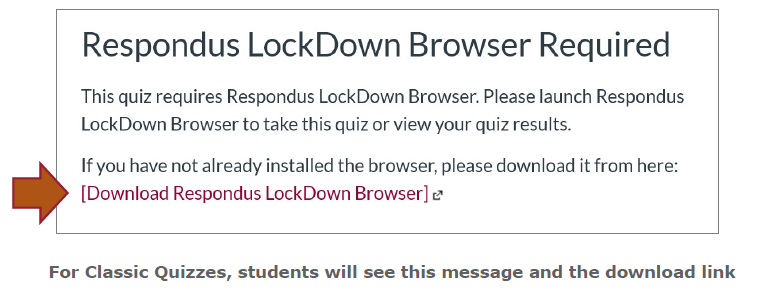
The Respondus Monitor Proctoring Reports
Enabling LockDown Browser and Respondus Monitor, and the ability to view class and individual results, occurs from the LockDown Browser Dashboard, available from the LockDown Browser link on your course navigation menu.

Once a completed quiz has been processed, navigate to the LockDown Browser Dashboard and select Class Results from the menu to the left of the quiz name. The class list and proctoring results for the exam will appear. The flags (if any) will be shown on the timeline and you can review any part of the quiz video.
Here is a document from Respondus that will help you interpret your results.
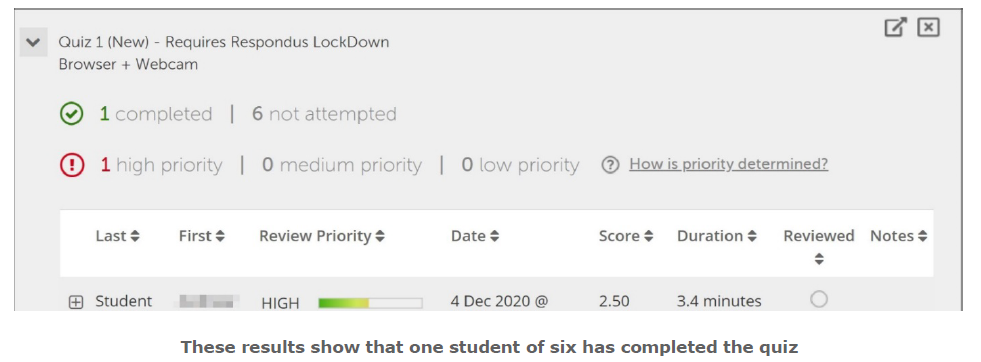
Selecting a student will expand the details for that students attempt, and allow you to see the various frame images and review the video. The Review Priority is a comprehensive measure that conveys whether a student's quiz session warrants a closer look.
Results appear in Low, Medium, and High categories with a green-to-red bar graph conveying the risk level.
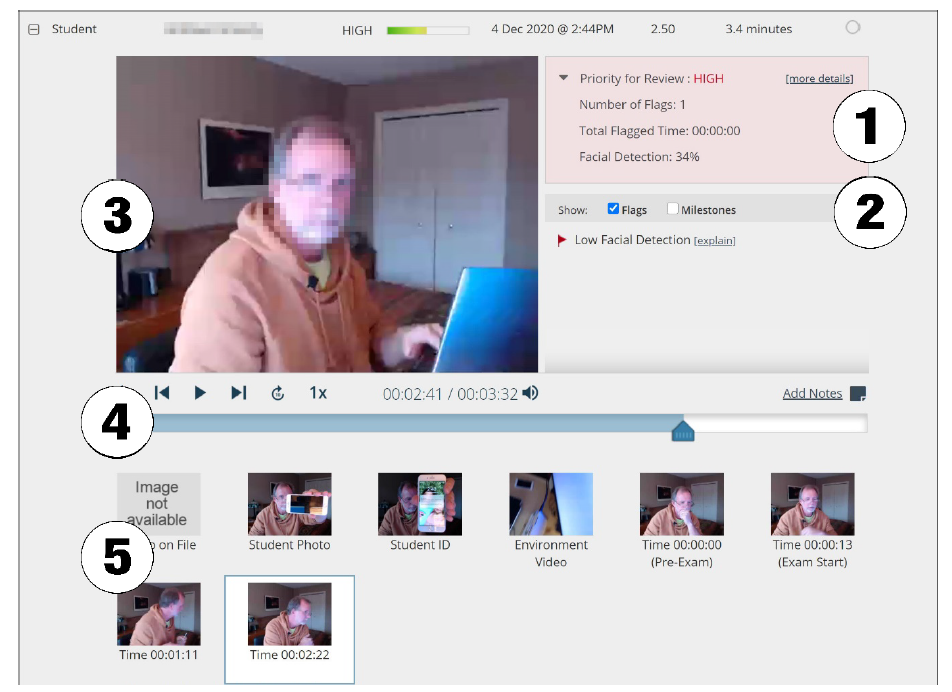
An individual student's Proctoring Results, showing: 1) Summary of key data, 2) List of Flags and Milestones, 3) Video playback and controls, 4) Timeline with flags and milestones, 5) Thumbnail images from video

